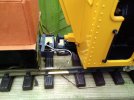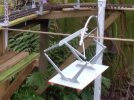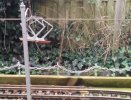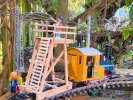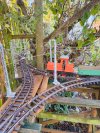BEHIND THE SCENES
That Christmas Train video looks pretty straightforward. But the reality behind something simple-seeming can sometimes be complicated. Today I'd like to share with you what I ran into when making that simple video.
The first complication was the weather. After I'd put the train together, it was wet and gloomy outside and remained so for days. So, on the first occasion the weather was a bit brighter (and I didn't have to work) I went outside with my train. This was already an involved process, as the workshop is on the first floor, so I took individual wagons downstairs into the kitchen, which thereby became rather unusable, and then the back door had to remain open despite the cold while I walked back and forth with individual wagons. Once outside, I put everything on the track and had my phone ready.
For this train, I didn't want to try Live Steam because it is still very new to me, so I hooked up the electric power to the tracks. This in turn ruled out Route Two, the long route, as the power is fed into the tracks at only one point, and part of Route Two is too far from that feeding point. So the Christmas Train would run on Route One.
To my surprise, none of my electric locos was able to pull the train. I'm not sure what caused this, as the train isn't particularly long or heavy. I found that a combination of two locos would do it, but I didn't like the looks of that combination, and for a Christmas Train looks are important. My solution was to keep the front loco completely out of frame. This is why the video doesn't begin with a head-on "here she comes" shot.
Also, the distinct yellow of the front loco tended to randomly appear in the bit of video where the end of the train takes the curve, near the end of the video. I took me quite a few takes to get that right.
I had several problems near the bridge. It turns out Santa leans farther backwards than I thought he did, and he actually hit the girder of the bridge. Maybe the bridge itself was already not properly aligned, I can't say. Also, a pantograph got into trouble where one overhead mast is lower than all the others. (This is a self made plastic panto that isn't sprung and cannot lower itself.)
Both of these issues were addressed, but then came the biggest problem with the section near the bridge: it's about 3 metres from the feeding point and there wasn't enough current for the two locomotives to pull the train. I will look into my current supply. I will also create more feeder points. This last thing has long been on the "maybe one day" list, but has now moved up to the "2025 if not sooner" list.
So now I had to forego the section near the bridge. This left me with a C-shaped route, meaning I had to back the train up as far as possible, put it in forward motion, and then run to my video standpoint, which included one duckunder. Then I had to grab my phone, position myself, and start filming before the train arrived. Then I had to carefully back the entire train up to the starting point again. When putting the train in forward, I had to be careful of the train speed: a little too fast and I wouldn't be in time to film it, a little too slow and it would move irregularly. I think the final take errs on the slow side.
All in all, a far cry from my original idea of having the train run circles, with me standing around at ease, shooting my video shots.
Another strange discovery: officially the two locos have the same coupler height but in reality they don't. Some random uncouplings took place and I had to create a makeshift link that couldn't come loose. A piece of metal wire wound through the couplings hooks.
An issue that seems absurdly simple in comparison, is that I had doubts about the video quality of my phone. The later takes, including the one that made it into the final video, were shot with my tablet.
And finally, when filming was done and I was taking everything back inside, I made a clumsy mistake. The back door was open again, and what with the cold, and a housemate going about their life, this got me into a bit of a hurry. I was trying to lift both locomotives off the track, hampered by them still being linked by a piece of metal wire. One way or another I wasn't careful enough and I ended up slamming that pantograph into the overhead. In the photos you can see it dangling there, with the roof of the loco still attached.
Now this may sound like more of a calamity than it is: that loco always had a loose roof, because I always knew I might one day want to replace the panto with a working one. Attached to a new roof. Swappable roofs. It seems the time has come for that project.
So there you have it: the trials and tribulations of shooting a simple-seeming Christmas video.
